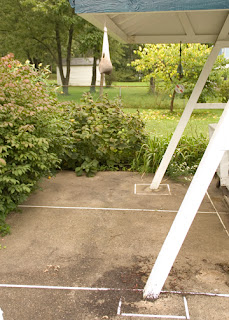 |
| That is black thistle seed on the concrete |
I decided to make a new sock. I searched my house for some kind of material. I didn't have the knit fabric used in the store bought socks. The kind of material used in sport clothing. I'm not nor ever have been, what you would call, athletic.
 |
| Fabricline.com |
 |
| 10" x 24" |
 |
| 10" x 24" doubled now 5" x 24" |
I used a funnel with a large throat to fill the sock and tapped the sock on my kitchen counter to get in the maximum amount of seed. I then cut a 10" length of 1/8" cord. I used an overhand knot in the loose ends and formed a circular cord. I then gathered and twisted the top of the sock made from the screening material. Placed the circular cord around the gathered and twisted sock and slipped the doubled cord into itself and pulled the longer end of the cord, tightening it around the sock.
Now it was time to test the finches ability to get the seeds out through the screening. I hung my new feeder next to one of the store bought sock feeders. I figured by placing the new feeder next to the old feeder it would shorten the discovery time for the gold finch.
I built it, now they would come. By the end of the second day, only one female gold finch was feeding at the new sock. She was able to extract seeds. My creation was a success, sort of.
The one an only female gold finch I saw feeding had ripped the screening material to get to the seeds. Oh, well! Back to the drawing board.
I will bring my new sorry feeder inside, pour all of the seeds into a sealable plastic bag and store them until next spring when the gold finches return. Until then, I am thinking about the overwintering birds in my backyard.
©Damyon T. Verbo - all rights reserved





No comments:
Post a Comment
Don't be shy. Leave a comment. I won't bite your head off.